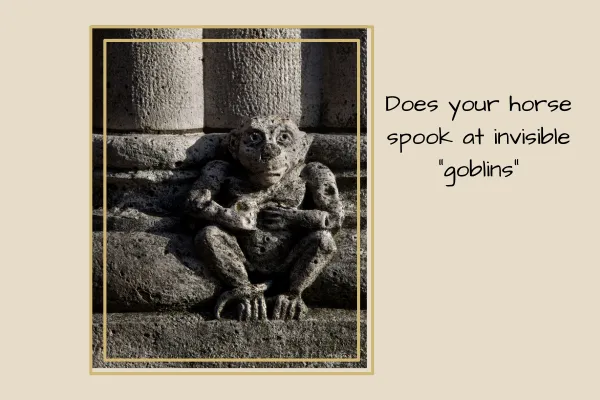
Are Goblins Lurking in Your Arena? How Balance Issues and Tension Are Connected
Have you ever wondered why your horse seems to see monsters in the corners, shies at shadows, or spooks at invisible threats? The answer might lie in their balance, body awareness, and confidence.
It’s worth taking a step back—no saddle, no bridle, completely gadget-free—to truly observe your horse. Watch how they move: neck, front legs, back legs, spine, and core. Knowing your horse’s "normal" look and feel helps you spot changes that may signal discomfort, imbalance, or insecurity.
Why Some Horses Struggle
Some horses move with natural grace, transitioning seamlessly between gaits—pure poetry in motion. Others may appear awkward, resembling a giraffe, a camel, or even a crash-test dummy, clumsily navigating their environment.
Horses also see the world differently than we do. A harmless rock might look like a crouching predator. Monsters, goblins, and gremlins in every corner? Often, these behaviors stem from physical imbalances and alignment issues. One side is usually more affected than the other, and this imbalance can lead to spooking, bracing, and resistance.
How to Help Your Horse Find Balance
Good training can transform these issues. Through groundwork, lunging, and careful riding, you can help your horse:
Align their body
Develop awareness of each leg
Strengthen muscles and ligaments
Improve coordination and weight distribution
Using tools like a cavesson allows for light control and encourages the horse to explore solutions within its own body. The goal isn’t to force the horse into a position but to guide it toward balance and harmony.
As your horse gains confidence and body awareness, those imaginary goblins and munchkins will fade away. They’ll move more willingly, trust you as a partner, and adopt a healthier, more balanced frame. It’s not instant, but the results are magical—a happy, healthy horse that enjoys their work.
Tips for Success:
Take It Slow: Every horse progresses at its own pace. Focus on small, consistent improvements.
Be Patient: Resistance and tension take time to fade, especially if the horse has experienced restrictions in the past.
Breaks Are Key: Let your horse relax and be playful during sessions. It helps both of you reset and recharge.
Stay Curious: Always ask questions and observe your horse’s responses. Learning is a lifelong journey for both horse and rider.
Build Your Team: Work with knowledgeable professionals—bodyworkers, farriers, saddle fitters, and coaches—to support your horse’s health and well-being.
The Rider’s Role
It’s easy to look for external solutions—bits, saddles, shoeing, or treatments—but don’t take yourself out of the equation. Everything you do (or don’t do) impacts your horse. Building a true partnership requires awareness, effort, and trust.
By investing time and care, you’ll create a bond that allows your horse to move confidently through the world—no goblins or munchkins in sight. Your reward is a horse that’s happy, sound, and ready to work with you in harmony.
